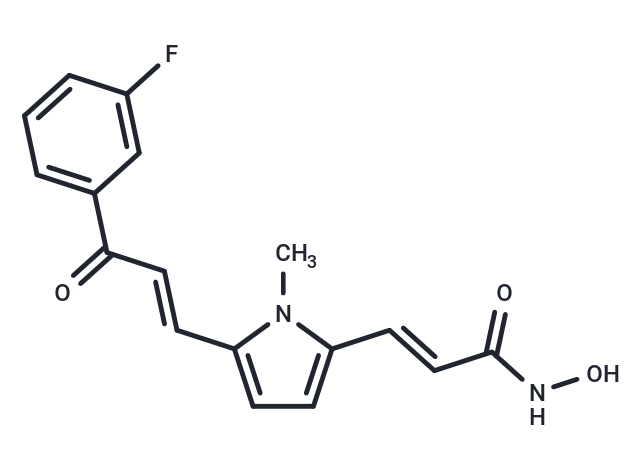Shopping Cart
- Remove All
 Your shopping cart is currently empty
Your shopping cart is currently empty

MC1568 is a specific HDAC inhibitor for maize HD1-A (IC50: 100 nM, in a cell-free assay). It is 34-fold more selective for HD1-A than HD1-B.

| Pack Size | Price | Availability | Quantity |
|---|---|---|---|
| 5 mg | $32 | In Stock | |
| 10 mg | $52 | In Stock | |
| 25 mg | $94 | In Stock | |
| 50 mg | $145 | In Stock | |
| 100 mg | $262 | In Stock | |
| 200 mg | $455 | In Stock | |
| 1 mL x 10 mM (in DMSO) | $50 | In Stock |
| Description | MC1568 is a specific HDAC inhibitor for maize HD1-A (IC50: 100 nM, in a cell-free assay). It is 34-fold more selective for HD1-A than HD1-B. |
| Targets&IC50 | HD1-A (Maize):100 nM |
| In vitro | In pancreatic transplantation research, MC1568 significantly enhances endocrine β and δ-cells and increases the expression of Pax4. In vivo in mice, MC1568 (50 mg/kg) selectively and markedly inhibits HDAC. Within PPRE-Luc mice, MC1568 (50 mg/kg) specifically disrupts PPARγ signaling in the heart and adipose tissues. When acting on skeletal muscle and heart, MC1568 inhibits the activity of HDAC4/5 without affecting HDAC3 activity, leaving the MEF2-HDAC complex in an inactive state. |
| In vivo | MC1568 selectively inhibits HDAC class II with an IC50 of 220 nM, showing 176 times greater selectivity compared to class I HDACs. In C2C12 cells, MC1568 (5 μM) stabilizes the HDAC4-HDAC3-MEF2 (Myocyte Enhancer Factor 2D) complex by reducing MEF2D expression, blocking myogenic differentiation through inhibition of MEF2D acetylation. Additionally, MC1568 at 5 or 10 μM disrupts the RAR (Retinoic Acid Receptor) and PPARγ (Peroxisome Proliferator-Activated Receptor Gamma)-mediated differentiation signaling pathways. In MCF-7 cells, a concentration of 20 μM MC1568 enhances the accumulation of acetylated H3 and H4 histones and acetylated tubulin levels, indicating inhibition of HDAC6. Experiments with human breast cancer ZR-75.1 cell lysates show that MC1568 does not inhibit HDAC1 but does inhibit HDAC4. In F9 cells, MC1568 selectively inhibits endodermal differentiation without affecting VA (Vitamin A)-induced maturation in early promyelocytic NB4 cells. Furthermore, in 3T3-L1 cells, MC1568 reduces PPARγ-induced adipogenesis. |
| Kinase Assay | Maize HD2, HD1-B, and HD1-A Enzyme Inhibition.: The enzyme liberats tritiated acetic acid from the substrate, which is quantified by scintillation counting. IC50 values are results of triple determinations. A 50 μL sample of maize enzyme (at 30 °C) is incubated (30 min) with 10 μL of total [3H]acetate-prelabeled chicken reticulocyte histones (2 mg/mL). Reaction is stopped by addition of 50 μL of 1 M HCl/0.4 M acetate and 800 μL of ethyl acetate. After centrifugation (1×104 g, 5 min), an aliquot of 600 μL of the upper phase is counted for radioactivity in 3 mL of liquid scintillation cocktail. MC1568 is tested at a starting concentration of 40 μM, and active substances are diluted further. NaB, VPA, TSA, SAHA, 85 TPX, HC-toxin, and tubacin are used as the reference compounds, and blank solvents are used as negative controls. |
| Cell Research | The 3T3-L1 cells are propagated and differentiated using a cocktail of isobutylmethylxanthine, dexamethasone, and insulin. From the second day post-confluence and throughout the differentiation period of 8 days, the 3T3-L1 cells are induced by: (1) no induction: at post-confluence and throughout the differentiation period of 8 days, the cells are incubated with DMSO or MC1568. (2) troglitazone: at post-confluence and throughout the differentiation period of 8 days, the cells are induced with 5 μM troglitazone, MC1568, or both. (3) rosiglitazone: at post-confluence and throughout the differentiation period of 8 days, the cells are incubated with 1?μM rosiglitazone and either DMSO or MC1568. (4) rosiglitazone and dexamethasone: at post-confluence, the cells received 1?μM of rosiglitazone and 390?ng/mL dexamethasone. Throughout the differentiation period of 8 days, the cells are induced with 1?μM of rosiglitazone and either DMSO or MC1568. All medium is renewed every second day.(Only for Reference) |
| Molecular Weight | 314.31 |
| Formula | C17H15FN2O3 |
| Cas No. | 852475-26-4 |
| Smiles | Cn1c(\C=C\C(=O)NO)ccc1\C=C\C(=O)c1cccc(F)c1 |
| Relative Density. | 1.21 g/cm3 (Predicted) |
| Storage | Powder: -20°C for 3 years | In solvent: -80°C for 1 year | Shipping with blue ice. | |||||||||||||||||||||||||
| Solubility Information | H2O: < 1 mg/mL (insoluble or slightly soluble) Ethanol: < 1 mg/mL (insoluble or slightly soluble) DMSO: 11 mg/mL (35 mM), Sonication is recommended. | |||||||||||||||||||||||||
Solution Preparation Table | ||||||||||||||||||||||||||
DMSO
| ||||||||||||||||||||||||||

Copyright © 2015-2025 TargetMol Chemicals Inc. All Rights Reserved.